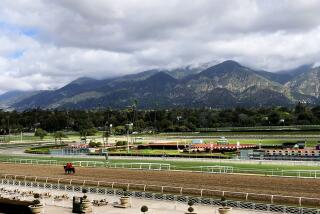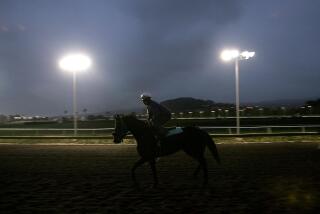Traveling in Style : PLACES OF THE HEART : Lexington : Kentucky’s Best Bet : For Horseracing Purists, Keeneland Is a Little Green Corner of Heaven
- Share via
I don’t really believe in a life after death, but if there is a heaven, I want it to look something like the Keeneland Race Course outside of Lexington, Ky. I’ve been a dedicated horseplayer ever since the age of 16, when I was whisked to Belmont Park in New York by a degenerate older cousin, and we picked six winners in a row.
I grew up believing that all racetracks were pretty much the same--great drafty grandstands overlooking the racing ovals, populated largely by losers. When I moved to California in the mid-’60s, I discovered that racing could also be fun, conducted in informal outdoor settings against cheerful-looking backdrops of sea and mountains. Here, horses are an intimate part of the local racing scene as opposed to the tracks in the East, where the animals are so distant from the fans that they are best observed on TV monitors. California racetracks have come to represent for me the ultimate in horseplaying pleasure, a perfect blending of chance and aesthetics.
That was before I discovered Keeneland. I went to Kentucky last year for the same reason pilgrims flock to Jerusalem, Rome and Mecca. My religion is horses, and the capital of the horse kingdom is Lexington, which sits in the center of the so-called Bluegrass Country, a land of lush rolling meadows, barns, palatial dwellings, endless wooden fences, tobacco fields, cattle pastures and narrow country roads that weave through it all like the strands of a spider web. To see it best, I drove into the state from the east in late April, two weeks before the running of the Kentucky Derby in nearby Louisville. It is equivalent to arriving in Rome during Easter week. There is a feeling of anticipation in the air, of faith renewed, and it is contagious.
I was intellectually prepared for the beauties of the horse country--but not emotionally. When I turned off the main highway onto the back roads, I found myself cruising along beside a herd of mares with new foals by their sides. It was a sight most horseplayers never see, mainly because it is not a betting proposition.
I spent a few days as a guest at Jonabel, a 760-acre spread a few miles west of Lexington that is home to several hundred broodmares, their new foals and yearlings and eight stallions, whose progeny keep the racing establishment supplied with competitors year after year. The horses receive better care than most human beings. I watched a mare give birth late one afternoon on a patch of lawn outside her stable with three expert hands in attendance. It was an easy birth, with the foal emerging as it is supposed to, front feet first with its head tucked between its legs, and an hour and 20 minutes later it was on its feet, nestling against its mother. In the breeding shed, a stallion named Slewpy was being mated to a panicky 3-year-old filly in a ceremony devoid of ritual and delicacy but astonishing for the meticulous care with which the human attendants made sure the act was fully consummated.
Casual visitors are not allowed to simply drop in at most of the horse farms, but some provide occasional tours during special events such as the Equifestival of Kentucky, scheduled for October. The 10-day event features concerts, museum and art exhibits, plays historical celebrations and guided tours of some of the larger farms, such as Calumet, Spendthrift, Claiborne, Gainesway and Land’s End.
I discovered while hanging out that Kentucky teems with “good ole boys” who tend to burst into bloom if you mention the word horses and who are not only accommodating but full of good stories about their fabled charges. A $5 tip to the attendant who shows you around will almost always loosen tongues and get you up close to one or another of the retired champions that grace the breeding sheds.
Two of the greatest racehorses that ever lived, John Henry and Forego, are available for daily inspection at the Kentucky Horse Park, a 1,000-acre public facility five or six miles out of Lexington that includes a half-mile exercise track, dressage arenas and several collections and museums, one devoted to the horse in general and others to specialized breeds and activities. Several times a year, the park is the site of equestrian competitions, including the Rolex Three-Day Event in which horses and riders are chosen for the Olympics and other international competitions. But the most popular attraction at the park is grumpy old John Henry, who, in 1984, was still winning important races at the advanced age of 9 and who earned more money in his lifetime than any horse before him. He and Forego, a huge horse whose fragile ankles made it impossible for him to run more than a few times a year (although in his best days, he could have beaten even John Henry), are at the horse park instead of a breeding farm because they are geldings. Some racehorses’ penchant for brawling or mating can only be cured through drastic surgery.
I DISCOVERED KEENELAND TWO days after I arrived in Lexington. The track is only open for racing twice a year, for a couple of weeks in April and again in October. Conceived during the Depression by a celebrated horseman named John Oliver (Jack) Keene, the facility is the site of four annual yearling sales that are the most important in the nation: In 1988, gross sales totalled about $400 million. The racing is strictly a secondary activity and largely divorced from the profit motive. Stockholders receive no dividends, and all net earnings are poured back into capital improvements and purses for the horsemen. Money is also donated to charities, educational organizations and equine research. The emphasis here is on the sport itself; in an era when the nation’s racetracks are regarded by the politicians who license them as machines for separating the betting public from its dollars and greasing the wheels of government, Keeneland is unique.
I drove into Keeneland through groves of dogwoods and other flowering trees in whose shade I had no trouble finding a parking place. I walked into the grandstand, which looked more like an Ivy League football stadium than a betting emporium, and found a seat overlooking the main dirt oval--1 1/16th miles in circumference--and lush-looking inner turf course. Everywhere I gazed, I saw trees, hedges and green fields, while the people around me had a cheerful country look, as if they had come to attend a county fair. It was a revelation to me, a pastoral celebration of sport totally removed from the atmosphere I had grown up in--that of incipient desolation and carnage populated in part by addicts about to blow their welfare checks on the daily double.
I almost missed getting a bet down on the first race because I became immersed in my Racing Form and didn’t hear the announcer informing the public that the horses were nearing the starting gate. Then I remembered with a start that Keeneland has no public announcer; the horses simply appear on the track for their race, and the tote board records the changing odds. The assumption at Keeneland is that if you need to be told what is happening at a racetrack, you shouldn’t be there.
I didn’t cash a ticket that first day at Keeneland, but somehow it didn’t seem to matter. I spent some of the time between races watching the horses being saddled under the trees and paraded around the grassy walking ring before filing out toward the track through a tunnel under the stands. Everyone there seemed to be well-heeled, with the gentlemen wearing coats and ties and the ladies mostly in dresses or elegant pants suits. I began to imagine myself a member in good standing of an elite cadre of sportsmen for whom the Thoroughbred symbolized class and grace and consummate style. I walked out of the track that afternoon entirely at peace with myself, indifferent to my dismal handicapping and empty wallet.
The next morning, I got up at dawn and went out to the track. I mingled with the horse people, listening to the talk and the jokes. While I kept an eye focused out there where the animals galloped, jogged or ran, the sounds of their hoofs beat a tattoo in the soft earth as the early-morning sun warmed my shoulders. After the workouts, I stopped by the Keeneland Kitchen, the stable-area cafeteria, where, over a typical light Kentucky breakfast of fried eggs, grits, biscuits, gravy and hot coffee, I communed with the horsemen, bought myself a Racing Form and set to work isolating possible winners from the onrush of statistics. If there’s a better way to spend time than by going racing at Keeneland, I haven’t found it. The grass isn’t really blue in Kentucky; the blood is.
GUIDEBOOK: Keeneland Race Course
The track is located at 4201 Versailles Road, Lexington, Ky. 40592; (606) 254-3412. Races held Wednesday through Sunday in April, Tuesday through Sunday in October, although open to the public year round.
Tours: Horse-farm tours can be booked year-round through a number of companies, including Historic & Horse Farm Tours, P.O. Box 22593, Lexington, Ky. 40522; (606) 268-2906.
Information: For details on October Equifestival as well as other horse-farm tour companies, contact Greater Lexington Convention & Visitors Bureau, (800) 848-1224.
More to Read
Sign up for The Wild
We’ll help you find the best places to hike, bike and run, as well as the perfect silent spots for meditation and yoga.
You may occasionally receive promotional content from the Los Angeles Times.






